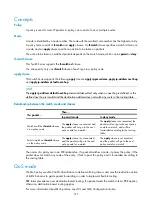
390
CEs and PEs mark the boundary between the service providers and the customers.
After a CE establishes adjacency with a directly connected PE, it advertises its VPN routes to the PE and
learns remote VPN routes from the PE. A CE and a PE use BGP/IGP to exchange routing information. You
can also configure static routes between them.
After a PE learns the VPN routing information of a CE, it uses BGP to exchange VPN routing information
with other PEs. A PE maintains routing information about only VPNs that are directly connected, rather
than all VPN routing information on the provider network.
A P router maintains only routes to PEs and does not deal with VPN routing information.
When VPN traffic travels over the MPLS backbone, the ingress PE functions as the ingress Label Switching
Router (LSR), the egress PE functions as the egress LSR, and P routers function as the transit LSRs.
MPLS L3VPN concepts
Site
Sites are often mentioned in the VPN. A site has the following features:
•
A site is a group of IP systems with IP connectivity that does not rely on any service provider network
to implement.
•
The classification of a site depends on the topology relationship of the devices, rather than the
geographical positions, though the devices at a site are, in most cases, adjacent to each other
geographically.
•
The devices at a site can belong to multiple VPNs.
•
A site is connected to a provider network through one or more CEs. A site can contain many CEs,
but a CE can belong to only one site.
Sites connected to the same provider network can be classified into different sets by policies. Only the
sites in the same set can access each other through the provider network. Such a set is called a VPN.
Address space overlapping
Each VPN independently manages the addresses it uses. The assembly of such addresses for a VPN is
called an address space.
The address spaces of VPNs may overlap. For example, if both VPN 1 and VPN 2 use the addresses on
network segment 10.110.10.0/24, address space overlapping occurs.
VPN instance
In MPLS VPN, routes of different VPNs are identified by VPN instance.
A PE creates and maintains a separate VPN instance for each VPN at a directly connected site. Each
VPN instance contains the VPN membership and routing rules of the corresponding site. If a user at a site
belongs to multiple VPNs at the same time, the VPN instance of the site contains information about all of
the VPNs.
For independence and security of VPN data, each VPN instance on a PE maintains a relatively
independent routing table and a separate label forwarding information base (LFIB). VPN instance
information contains the following items: the LFIB, IP routing table, interfaces bound to the VPN instance,
and administration information of the VPN instance. The administration information of the VPN instance
includes the route distinguisher (RD), route filtering policy, and member interface list.
















































